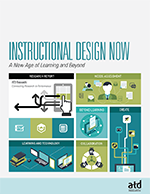ATD Blog
Approaches, Attitudes, and Challenges of Today’s Instructional Designer
Wed Mar 18 2015

Today’s instructional design (ID) professional certainly has a challenging but potentially rewarding job. These learning professionals are responsible for building effective, engaging, and accessible training experiences for diverse workforces. To do this successfully, they must keep up with changes in both the skills needed by their organizations’ workforces and learning technologies.
Recently, ATD and the Institute for Corporate Productivity (i4cp) took a close look at instructional design in organizations. The March 2015 report from ATD Research and i4cp, Instructional Design Now: A New Age of Learning and Beyond, paints a picture of today’s instructional designers, including their backgrounds, the approaches they rely on, the challenges they face, and their views toward their work. To supplement the report, ATD Research and i4cp are also hosting a free webcast, the details of which can be found below.
Where Instructional Designers Work and Their Backgrounds
The project surveyed 1,120 ID professionals, the majority of whom practice within organizations large (more than 1,000 employees). Of the survey participants, 46 percent have a formal undergraduate or graduate degree in ID or a related field. The large majority (over 80 percent) of those with a formal degree felt that their degree played an important role in supporting their career.
In addition to degrees, there are professional certifications that are available to instructional designers. About a sixth of those surveyed hold a certification, with the top choice being ATD’s Certified Professional in Learning and Performance (CPLP).
Approaches, Attitudes, and Challenges
Instructional designers draw on both traditional methods (such as classroom learning, which is still used in over 90 percent of organizations) and newer, technology-based methods. According to respondents, blended learning, which combines multiple learning methods such as live classroom learning mixed with electronic learning modules or mobile learning, is used in more than 70 percent of organizations. Designing blended learning, however, requires a broad set of capabilities and understanding of a range of methodologies, many of which change quickly because of their reliance on technology.
So, how do ID professionals view their own work? Unfortunately, less than four out of 10 respondents felt that ID was effective in addressing learning needs in their organizations. The top barriers to success for ID initiatives were a lack of support of ID from upper management and a lack of internal staff who have the competencies and skills to meet the design requirements of ID initiatives.
Register for the March 30 Webcast!
Are you interested in learning more about this research and what underlies successful ID initiatives at a leading organization?
On Monday, March 30, 2015, at 1:00 p.m. EST, ATD Research and Carol Morrison of i4cp will discuss the research results. The webcast also will feature Nanette Temby, who leads the Field Skills Development team of the US Training and Development organization at Novartis Pharmaceuticals Corporation. In that capacity, she builds the advanced sales competencies curriculum at Novartis, approximately half of which is delivered using virtual classrooms and mobile learning. Nanette holds a Master of Education in Instructional Design. Anyone can register for the free webcast here.
Learn More
The full report is available at https://www.td.org/product/research-report--instructional-design-now-a-new-age-of-learning-and-beyond/791502. Members have complimentary access to a whitepaper version of the report, and anyone may download the infographic for free.
